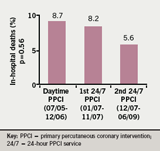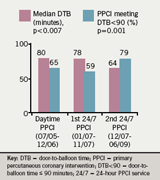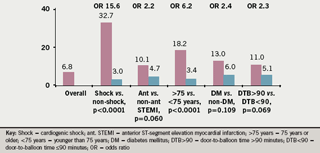Sandwell General Hospital is an acute district general hospital that provides primary angioplasty service without on-site cardiac surgical facilities. The service was rolled out in stages in July 2005 and achieved 24-hour status by January 2007. Its two distinguishing features are collaboration with its partner hospital of the same National Health Service (NHS) trust for after-hours angioplasties, and mobilisation of interventional cardiologists to whichever one of the two hospitals that patients present to. We aimed to show that 24-hour primary angioplasty service by this collaboration is feasible and can achieve recommended door-to-balloon times. A retrospective audit of the British Cardiovascular Intervention Society database of 381 primary angioplasties over a four-year period from June 2005 to June 2009 was performed.
Median door-to-balloon time improved from 80 minutes (interquartile range [IQR] 51 to 107) to 64 minutes (IQR 50 to 85; p<0.007) and the percentage of primary angioplasties achieving recommended door-to-balloon time of ≤90 minutes increased from 65% (45/69) to 79% (169/214; p=0.001). In-hospital deaths were 3.0% (10/332) for patients without cardiogenic shock and 6.8% (26/381) for all-comers. We conclude that 24-hour primary angioplasty service in a collaboration of district general hospitals with a physician-to-patient no-transfer approach can achieve favourable door-to-balloon times.
Introduction
 Prompt primary percutaneous coronary intervention (PPCI) is the preferred treatment for patients presenting with ST-segment elevation myocardial infarction (STEMI).1 Clinical outcomes are better with higher procedural volume2 and the intuitive deduction is that PPCIs should be performed by high-volume, usually large, tertiary hospitals. Provision of 24-hour PPCIs by collaboration of other hospitals such as district general hospitals (DGHs) has not been studied in detail.
Prompt primary percutaneous coronary intervention (PPCI) is the preferred treatment for patients presenting with ST-segment elevation myocardial infarction (STEMI).1 Clinical outcomes are better with higher procedural volume2 and the intuitive deduction is that PPCIs should be performed by high-volume, usually large, tertiary hospitals. Provision of 24-hour PPCIs by collaboration of other hospitals such as district general hospitals (DGHs) has not been studied in detail.
Sandwell General Hospital is an acute DGH that provides PPCI service without on-site cardiac surgical facilities to a catchment population of 250,000. The service was rolled out in stages in July 2005 and achieved 24-hour status by January 2007. Its two distinguishing features are collaboration with its partner hospital of the same National Health Service (NHS) trust for after-hours PPCIs and mobilisation of interventional cardiologists to whichever one of the two hospitals that patients present to. PPCIs are activated by emergency physicians and the interventional team is available within 30 minutes of travelling time. We aimed to demonstrate that this model is feasible and can achieve favourable door-to-balloon (DTB) times.
Materials and methods
Patients
A retrospective audit of the British Cardiovascular Intervention Society database was carried out on consecutive patients receiving PPCIs. The PPCIs occurred in three periods over four years: first period consisting of daytime-only (8am–8pm) PPCIs (five days a week in July 2005–January 2006 and seven days a week in February 2006–December 2006) and second period consisting of 24-hour PPCIs (January 2007–November 2007). The results of these two periods were presented at the British Cardiovascular Society (June 2008).3 Subsequent PPCIs constituted the third period consisting of 24-hour PPCIs (December 2007–June 2009).
Outcome measures
We examined median DTB times and percentage of PPCIs that met target DTB time. DTB time is the interval between arrival in hospital and first balloon dilatation of the blocked coronary vessel, and the recommendation is that this opening should be achieved in less than 90 minutes. The two audit standards for this study are a median DTB time ≤90 minutes and ≥75% of PPCI achieving the recommended DTB time.4,5
Statistical methods
Categorical variables were expressed as numbers with percentage or as odds ratio (OR) with 95% confidence interval (CI) and compared using Fisher’s exact or chi square tests. Continuous variables were expressed as mean ± one standard deviation or as median with IQR and compared using Kruskal Wallis test. All p values are two-tailed and values greater than 0.05 are considered to represent statistical non-significance (NS).
Results
Baseline demographics
Number of patients analysed was 381 after excluding 15 patients (4%) without DTB times from 396 patients. Mean age was 63 ± 14 (range 26–100) years and 287 (75%) were males. One hundred and forty-one patients (27%) were current smokers, 132 (26%) had hyperlipidaemia and 171 (31%) hypertension. Cardiogenic shock, anterior STEMI, age ≥75 years and diabetes mellitus were considered high-risk STEMI features4 and patients were distributed as follows: 49 (13%) had cardiogenic shock, 149 (39%) anterior STEMI, 88 (23%) were 75 years or older and 46 (12%) had diabetes.
Outcomes


Median DTB time improved from 80 minutes (IQR 51 to 107) to 64 minutes (IQR 50 to 85) (p<0.007) and the percentage of PPCIs achieving target DTB time increased from 65% (45/69) to 79% (169/214) (p=0.001) (figure 1). There was a statistically non-significant trend that in-hospital deaths improved across these periods from 8.7% (6/69) to 5.6% (12/214) (p=0.56) (figure 2).

Overall in-hospital deaths were 6.8% (26/381). Patients with cardiogenic shock had higher mortality of 33.0% (16/49) compared with 3.0% (10/332) for those without shock (OR 15.61, 95% CI 6.66 to 36.59, p<0.0001). Patients who missed target DTB time showed a statistically non-significant trend of higher mortality of 11.0% (12/109) compared with 5.1% (14/272) for patients who met target DTB time (OR 2.28, 95% CI 1.04 to 5.02, p=0.069). These, and in-hospital deaths for the other risk groups (anterior STEMI, age and diabetes status), are shown in figure 3.
Discussion
Both the audit standards were achieved. Seventy-nine per cent met the target DTB time and final median DTB of 64 minutes compares favourably to the average median DTB time of 100.4 minutes in the United States6 and 59.4 minutes (which included shorter second DTB times from hospitals receiving transfers) in the UK.7 Our overall in-hospital deaths of 3.0% for non-shocked patients were comparable with the average rate of 4.8% in the UK.7
The default treatment prior to our PPCI programme was thrombolysis followed by pre-discharge coronary angiographies, percutaneous coronary interventions (PCIs) and rescue PCIs as necessary. The programme merely brought forward these pre-discharge procedures and did not require additional staffing as the hospital was already staffed for after-hours rescue PCIs. These reasons should, therefore, contribute favourably to the cost-effectiveness of the programme even though this study did not formally assess the cost.
Because we did not transfer patients to other hospitals for PPCIs during the thrombolytic period, we could not directly compare our model against such a practice. Since the nearest hospital providing 24-hour PPCIs during our study period is 15 km or 30 minutes away, delays would necessarily and intuitively be incurred if we were to transfer, and these delays could increase mortality.8
An alternative approach to PPCI is thrombolysis followed by urgent transfer for PCI (pharmaco-invasive strategy). Our programme was started when trials such as Assessment of the Safety and Efficacy of a New Treatment Strategy for Acute Myocardial Infarction (ASSENT-4)9 showed adverse outcomes with facilitated PCI, and earlier trials such as Combined Abciximab Reteplase Stent Study in Acute Myocardial Infarction (CARESS)10 that supported the pharmaco-invasive strategy were not yet available.
It should be noted that although both our hospitals have interventional cardiologists, not all collaborating hospitals need to have interventional cardiologists if at least one of them has interventional cardiologists that could be mobilised.
Our study had limitations. Other non-assessed variables that were improving the DTB times could be present in a retrospective study. Similarly, it was not possible to ascertain which component of the model (e.g. 24-hour versus daytime-only service, mobile interventional cardiologists versus transfer PPCIs, emergency physician’s activation versus cardiologist’s activation) improved the DTB times, and it was likely that they all contributed.
Conclusion
We conclude that 24-hour PPCI service by a collaboration of DGHs with a physician-to-patient no-transfer model is feasible and can achieve favourable DTB times.
Acknowledgements
We thank the paramedic, medical and interventional teams of Sandwell General and Birmingham City Hospitals for making the 24-hour primary angioplasty programme possible.
Conflict of interest
None declared.
Key messages
- Timely 24-hour primary angioplasty aiming for a door-to-balloon time of under 90 minutes is the treatment of choice for ST-segment elevation myocardial infarction
- Collaboration of district general hospitals with a physician-to-patient no-transfer approach can deliver a 24-hour primary angioplasty service with favourable door-to-balloon times
References
- Boersma E. Does time matter? A pooled analysis of randomized clinical trials comparing primary percutaneous coronary intervention and in-hospital fibrinolysis in acute myocardial infarction patients. Eur Heart J 2006;27:779–88.
- Spaulding C, Morice MC, Lancelin B et al. Is the volume-outcome relation still an issue in the era of PCI with systematic stenting? Results of the greater Paris area PCI registry. Eur Heart J 2006;27:1054–60.
- Kong PK, Connolly D, Ahmad R. Local provision of primary percutaneous coronary intervention in a district general hospital setting: extension to 24/7 provision dramatically reduces the need for rescue PCI with acceptable door-to-balloon times. Heart 2008;94:A143.
- Antman EM, Anbe DT, Armstrong PW et al. ACC/AHA guidelines for the management of patients with ST-elevation myocardial infarction: a report of the American College of Cardiology/American Heart Association Task Force on Practice Guidelines (Committee to Revise the 1999 Guidelines for the Management of Patients with Acute Myocardial Infarction). Circulation 2004;110:e82–e292.
- Antman EM, Hand M, Armstrong PW et al. 2007 focused update of the ACC/AHA 2004 guidelines for the management of patients with ST-elevation myocardial infarction: a report of the American College of Cardiology/American Heart Association Task Force on Practice Guidelines: developed in collaboration with the Canadian Cardiovascular Society endorsed by the American Academy of Family Physicians: 2007 writing group to review new evidence and update the ACC/AHA 2004 guidelines for the management of patients with ST-elevation myocardial infarction, writing on behalf of the 2004 writing committee. Circulation 2008;117:296–329.
- Bradley EH, Herrin J, Wang Y et al. Strategies for reducing the door-to-balloon time in acute myocardial infarction. N Engl J Med 2006;355:2308–20.
- Ludman PF. British Cardiovascular Intervention Society audit returns 2007, presented in Crewe, September 2008. Available from: http://www.bcis.org.uk/resources/audit/audit2007
- Rathore SS, Curtis JP, Chen J et al. Association of door-to-balloon time and mortality in patients admitted to hospital with ST elevation myocardial infarction: national cohort study. BMJ 2009;338:b1807.
- Assessment of the Safety and Efficacy of a New Treatment Strategy with Percutaneous Coronary Intervention (ASSENT-4 PCI) investigators. Primary versus tenecteplase-facilitated percutaneous coronary intervention in patients with ST-segment elevation acute myocardial infarction (ASSENT-4 PCI): randomised trial. Lancet 2006;367:569–78.
- Di Mario C, Dudek D, Piscione F et al. Immediate angioplasty versus standard therapy with rescue angioplasty after thrombolysis in the Combined Abciximab REteplase Stent Study in Acute Myocardial Infarction (CARESS-in-AMI): an open, prospective, randomised, multicentre trial. Lancet 2008;371:559–68.
